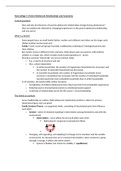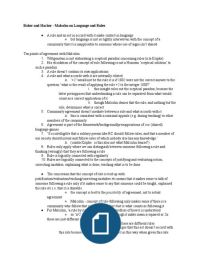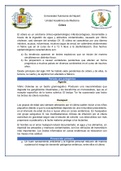Hoorcollege 5; Parent-Adolescent Relationships and Autonomy
Central questions
- How and why do (dynamics of) parent-adolescent relationships change during adolescence?
- How are adolescents affected by (changing) experiences in the parent-adolescent relationship,
and vice versa?
What is a family?
- Some people focus on small family (father, mother and children) and others on the larger units
(father/mother/uncles/aunts ect)
- Family = basic social unit group (married), traditionally consisting of 2 biological parents and
their children
- But, family comes in different forms and sizes, think about same sex parents, with/without
children or a larger size, which includes aunts/uncles/grandma or –pa etc.
- Structure common ‘historically’ are not as common today
o E.g., in terms of structure and size
o Also, culture-dependent
In white households, the number of fragmentary households has increased, and
the number of extended households has decreased
In nonwhite households, the number of fragmentary households (more
common in nonwhites) has increased, and the number of extended households
has decreased (but more extended households than in white households)
- In all societies, the family fulfills similar functions:
o Socialization of children/adolescents (here they have their first socialization experience)
o Enduring source of (practical/economic & emotional/social) support
o Continuity of relationships across the life course = social embedding
The family as a system
- Focus traditionally on mother-child/adolescent relationship (mother is often the primary
attachment figure and care giver)
- Family Systems Theory = an organized whole, consisting of interrelated parts that influence
each other
o System = set(s) of elements standing in interrelation among themselves and with the
environment
Interrelation = not A affects B, but A & B affect each other
Bidirectional/ reciprocal/ transactional effects
o Changing, self-organizing, and adapting to (changes in) its members and the outside
environment. So, because they are in constant interrelation, when someone is going
through a change, it affects the entire system
System is flexible, but strives for stability (= equilibrium)
, o Family = cohesive emotional unit (strong emotional bonds)
3 aspects within family system theory
- Holism
o To understand family, not enough to look at members separately, but you have to look
at the entire system
o Roles (e.g., caretaker)
One person has multiple roles (mom, spouse etc.)
When someone can't fulfill their role, someone must take it over
- Hierarchy/structure
o Members are organized into subsystems
By gender or generation
Individual level: one member within the system
Dyadic level:
o Marital relationship: mother-father
o Parent-child relationship: father-child and mother-child
o Sibling relationship
o Triadic relationship: parents-child
o Family level/whole
- Boundaries
o At every level (subsystems, inside/outside the family)
o Permeability varies across families
o Permeability evolves over time
o So, how much what happens within a specific subsystem of the family affects other
subsystems or the family as a whole
“Spillover” vs. “compensation”
Associations between dyadic relationships within the whole family =
When there are ‘loose’ boundaries between subsystems
Study: the family as a system: boundaries; spillover, compensation or compartmentalization
- Longitudinal study by Sherrill et al. (2017) in USA
- Sample of 60 parents with young adolescent between 10-14 years old
o Mage adolescents = 12.40 years old T1
o 75% biological mothers
o 73% African American/Black
- Parent-reports (telephone interviews within and across days)
o Interparental conflict (“Did you experience conflict with your spouse?”)
Result: more interparental conflict leads to more parent-adolescent conflict
within a day and 1 day later
o Parent-adolescent conflict (“Did you experience conflict with your child?”)
Result: more parent-adolescent conflict leads to more interparental conflict 1
day later
, - So, there is a presence of interparental conflict increases the odds of parent-adolescent conflict
at a later moment in time, and vice versa = “spillover”
o So, what happens in one system affects what happens in another system
Study: the family as a system: boundaries; why spillover
- Longitudinal study by Mastrotheodoros et al. (2020) in NL
- Sample of 443 Dutch adolescents + mothers
o Mage adolescents = 13.02 years old T1
o Completed 75 daily diaries across 15 weeks across 5 years
o
So, via individual mood
Study: the family as a system: boundaries; spillover bad?
- Longitudinal study by Kouros et al. (2014) in USA
- Sample of 203 early adolescents
o Mage adolescents = 13.17 years old
o Completed daily diaries across 15 days
- Mother- & father-reports
o Marital quality + parent-adolescent relationship quality (Overall rating of “emotional
quality of your relationship with your spouse/child” on specific day, with scale ranging
from 0 (negative) to 10 (positive)”)
-
o So, “Spillover” can be positive as well and some evidence for “compensation” in the
family system
Family as a system
- Adolescence = disruption of homeostasis
o New balance/equilibrium needs to be found
o Process of (family) adaptation
- Adolescent in a system
o 3 influences
Genotype
Shared environment
Unshared environment
o There is an overlap between genotype and shared environment, because parents
transmit their genes to the adolescent, and they also provide the parental environment
, Parenting styles
- Authoritative =
o Engage adolescent in decision making (e.g., rules)
o Encourage autonomy & independence
o Involved & monitoring (in a positive way)
o Open communication & trust
- Authoritarian =
o Strict rules & high expectations
o Discourage autonomy & independence (keep their kids, kids)
o Punishment-heavy (kids want to go against parents in adolescence)
o Low open communication & trust
- Indulgent =
o Do everything for their kids, but don't set rules/boundaries
o Very responsive to needs
o Insufficient parental guidance
o No behavioral expectations --> no control/punishment
o Adolescents require little self-regulation, because everything is okay (but they feel
loved)
- Indifferent/Neglectful =
o Not responsive to needs
o Insufficient parental guidance
o Provide basic needs, no more
o Uninvolved, detached, & disengaged
o No communication & trust
Central questions
- How and why do (dynamics of) parent-adolescent relationships change during adolescence?
- How are adolescents affected by (changing) experiences in the parent-adolescent relationship,
and vice versa?
What is a family?
- Some people focus on small family (father, mother and children) and others on the larger units
(father/mother/uncles/aunts ect)
- Family = basic social unit group (married), traditionally consisting of 2 biological parents and
their children
- But, family comes in different forms and sizes, think about same sex parents, with/without
children or a larger size, which includes aunts/uncles/grandma or –pa etc.
- Structure common ‘historically’ are not as common today
o E.g., in terms of structure and size
o Also, culture-dependent
In white households, the number of fragmentary households has increased, and
the number of extended households has decreased
In nonwhite households, the number of fragmentary households (more
common in nonwhites) has increased, and the number of extended households
has decreased (but more extended households than in white households)
- In all societies, the family fulfills similar functions:
o Socialization of children/adolescents (here they have their first socialization experience)
o Enduring source of (practical/economic & emotional/social) support
o Continuity of relationships across the life course = social embedding
The family as a system
- Focus traditionally on mother-child/adolescent relationship (mother is often the primary
attachment figure and care giver)
- Family Systems Theory = an organized whole, consisting of interrelated parts that influence
each other
o System = set(s) of elements standing in interrelation among themselves and with the
environment
Interrelation = not A affects B, but A & B affect each other
Bidirectional/ reciprocal/ transactional effects
o Changing, self-organizing, and adapting to (changes in) its members and the outside
environment. So, because they are in constant interrelation, when someone is going
through a change, it affects the entire system
System is flexible, but strives for stability (= equilibrium)
, o Family = cohesive emotional unit (strong emotional bonds)
3 aspects within family system theory
- Holism
o To understand family, not enough to look at members separately, but you have to look
at the entire system
o Roles (e.g., caretaker)
One person has multiple roles (mom, spouse etc.)
When someone can't fulfill their role, someone must take it over
- Hierarchy/structure
o Members are organized into subsystems
By gender or generation
Individual level: one member within the system
Dyadic level:
o Marital relationship: mother-father
o Parent-child relationship: father-child and mother-child
o Sibling relationship
o Triadic relationship: parents-child
o Family level/whole
- Boundaries
o At every level (subsystems, inside/outside the family)
o Permeability varies across families
o Permeability evolves over time
o So, how much what happens within a specific subsystem of the family affects other
subsystems or the family as a whole
“Spillover” vs. “compensation”
Associations between dyadic relationships within the whole family =
When there are ‘loose’ boundaries between subsystems
Study: the family as a system: boundaries; spillover, compensation or compartmentalization
- Longitudinal study by Sherrill et al. (2017) in USA
- Sample of 60 parents with young adolescent between 10-14 years old
o Mage adolescents = 12.40 years old T1
o 75% biological mothers
o 73% African American/Black
- Parent-reports (telephone interviews within and across days)
o Interparental conflict (“Did you experience conflict with your spouse?”)
Result: more interparental conflict leads to more parent-adolescent conflict
within a day and 1 day later
o Parent-adolescent conflict (“Did you experience conflict with your child?”)
Result: more parent-adolescent conflict leads to more interparental conflict 1
day later
, - So, there is a presence of interparental conflict increases the odds of parent-adolescent conflict
at a later moment in time, and vice versa = “spillover”
o So, what happens in one system affects what happens in another system
Study: the family as a system: boundaries; why spillover
- Longitudinal study by Mastrotheodoros et al. (2020) in NL
- Sample of 443 Dutch adolescents + mothers
o Mage adolescents = 13.02 years old T1
o Completed 75 daily diaries across 15 weeks across 5 years
o
So, via individual mood
Study: the family as a system: boundaries; spillover bad?
- Longitudinal study by Kouros et al. (2014) in USA
- Sample of 203 early adolescents
o Mage adolescents = 13.17 years old
o Completed daily diaries across 15 days
- Mother- & father-reports
o Marital quality + parent-adolescent relationship quality (Overall rating of “emotional
quality of your relationship with your spouse/child” on specific day, with scale ranging
from 0 (negative) to 10 (positive)”)
-
o So, “Spillover” can be positive as well and some evidence for “compensation” in the
family system
Family as a system
- Adolescence = disruption of homeostasis
o New balance/equilibrium needs to be found
o Process of (family) adaptation
- Adolescent in a system
o 3 influences
Genotype
Shared environment
Unshared environment
o There is an overlap between genotype and shared environment, because parents
transmit their genes to the adolescent, and they also provide the parental environment
, Parenting styles
- Authoritative =
o Engage adolescent in decision making (e.g., rules)
o Encourage autonomy & independence
o Involved & monitoring (in a positive way)
o Open communication & trust
- Authoritarian =
o Strict rules & high expectations
o Discourage autonomy & independence (keep their kids, kids)
o Punishment-heavy (kids want to go against parents in adolescence)
o Low open communication & trust
- Indulgent =
o Do everything for their kids, but don't set rules/boundaries
o Very responsive to needs
o Insufficient parental guidance
o No behavioral expectations --> no control/punishment
o Adolescents require little self-regulation, because everything is okay (but they feel
loved)
- Indifferent/Neglectful =
o Not responsive to needs
o Insufficient parental guidance
o Provide basic needs, no more
o Uninvolved, detached, & disengaged
o No communication & trust












